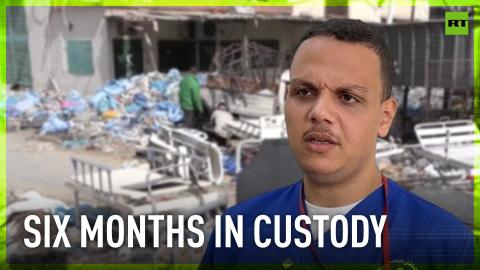Toxic chemicals released after train derailment in Ohio
0
0
24 Views
Published on 07 Feb 2023 / In
News & Politics
Crews in Ohio are beginning to release toxic chemicals from five cars of a train that derailed on Friday near the Pennsylvania state line to reduce the threat of an explosion. Ohio Gov. Mike DeWine earlier ordered residents near the site to evacuate saying there is a risk of death or serious injury.
-------------------------------------------------------------------------------------
Freedom over censorship, truth over narrative.
Follow us on Facebook: https://www.facebook.com/RTnews
Follow us on Telegram: https://t.me/rtnews
Follow us on Twitter: https://twitter.com/RT_com
Show more
0



 Freshfit
Freshfit
 SoloMan Zone
SoloMan Zone
 TheQuartering
TheQuartering
 The Realist Philosopher
The Realist Philosopher
 Sant77
Sant77

 RT
RT

 X22 Report
X22 Report
 Timcast IRL
Timcast IRL
![Ep. 3507a - Ron Paul Ready To Go After The [CB], Gold Purchases Accelerate](https://cdn.mgtow.tv/upload/photos/2024/11/fb42f8d1e97957491e893e8c8eb9bda1c2824abbRZ4NsBFMmDGL4eyoG6aB.video_thumb_high.jpg)



 Redacted News
Redacted News






Log in to comment
These profiteering railway owners cutting back on the safety and ramping up the profits - And people are dying......
Kill the owners and management of these business's.
Industrial Man Slaughter and Mass Murder.
I keep some kind of a track on hazardous chemicals and manufacturing things and there are things you must not fuck with and Vinyl Chloride is one of them.
It's like there were some sprays used in welding - called anti spatter spray - sort of like a cooking oil spray but sprayed over fittings and tools etc. and along the areas around the weld that you didnt want tiny moltern globs of welding spatter sticking too...
There were some types that when they were exposed to heat - they evaporated and the fume, in the presence of strong UV rays from the weld, converted from phosphates into phosgene - or mustard gas....
So inhaling small amounts over a long period of time, this was eating out the welders lungs and killing them.....
And some things are openly toxic, some things are only toxic under some circumstances and some things meh.... don't fuck with it and you will be right.
But vinyl chlroide - and it's precursors (what makes it up) are quite bad. Polymerising it makes it relatively stable and sort of safe-ish - but that stink of the PVC - has never smelled good or healthy - Don't you know..... for fucks sake...
Polymerised Vinyl Chloride - and it's precursors - being Vinyl Chroride....
https://en.wikipedia.org/wiki/Vinyl_chloride
Fire and explosion hazard
In the U.S., OSHA lists vinyl chloride as a Class IA Flammable Liquid, with a National Fire Protection Association Flammability Rating of 4. Because of its low boiling point, liquid VCM will undergo flash evaporation (i.e., autorefrigerate) upon its release to atmospheric pressure. The portion vaporized will form a dense cloud (more than twice as heavy as the surrounding air). The risk of subsequent explosion or fire is significant. According to OSHA, the flash point of vinyl chloride is −78 °C (−108.4 °F).[14] Its flammable limits in air are: lower 3.6 volume% and upper 33.0 volume%. The explosive limits are: lower 4.0%, upper 22.05% by volume in air. Fire may release toxic hydrogen chloride (HCl) and carbon monoxide (CO).[15] VCM can polymerise rapidly due to heating and under the influence of air, light and contact with a catalyst, strong oxidisers and metals such as copper and aluminium, with fire or explosion hazard. As a gas mixed with air, VCM is a fire and explosion hazard. On standing, VCM can form peroxides, which may then explode. VCM will react with iron and steel in the presence of moisture.[5][16]
Health effects
Vinyl chloride finds its major application in the production of PVC. It is volatile, so the primary exposure is via inhalation, as opposed to the consumption of contaminated food or water, with occupational hazards being highest. Prior to 1974, workers were commonly exposed to 1,000 ppm vinyl chloride, causing "vinyl chloride illness" such as acroosteolysis and Raynaud's Phenomenon. The symptoms of vinyl chloride exposure are classified by ppm levels in ambient air with 4,000 ppm having a threshold effect.[17] The intensity of symptoms varies from acute (1,000–8,000 ppm), including dizziness, nausea, visual disturbances, headache, and ataxia, to chronic (above 12,000 ppm), including narcotic effect, cardiac arrhythmias, and fatal respiratory failure.[18] RADS (Reactive Airway Dysfunction Syndrome) may be caused by acute exposure to vinyl chloride.[19]
Vinyl chloride is a mutagen having clastogenic effects which affect lymphocyte chromosomal structure.[18][20] Vinyl chloride is a Group 1 human carcinogen posing elevated risks of rare angiosarcoma, brain and lung tumors, and malignant haematopoeitic lymphatic tumors.[21] Chronic exposure leads to common forms of respiratory failure (emphysema, pulmonary fibrosis) and focused hepatotoxicity (hepatomegaly, hepatic fibrosis). Continuous exposure can cause CNS depression including euphoria and disorientation. Decreased male libido, miscarriage, and birth defects are known major reproductive defects associated with vinyl chloride.
Vinyl chloride can have acute dermal and ocular effects. Dermal exposure effects are thickening of skin, edema, decreased elasticity, local frostbites, blistering, and irritation.[18] The complete loss of skin elasticity expresses itself in Raynaud’s Phenomenon.[20]
Liver toxicity
This section needs to be updated. The reason given is: Okay, what about after 1969? Did the human race stop caring about this all of a sudden, or are there more papers we can find?. Please help update this article to reflect recent events or newly available information. (February 2023)
The hepatotoxicity of vinyl chloride has long been established since the 1930s when the PVC industry was just in its infant stages. In the very first study about the dangers of vinyl chloride, published by Patty in 1930, it was disclosed that exposure of test animals to just a single short-term high dose of vinyl chloride caused liver damage.[22] In 1949, a Russian publication discussed the finding that vinyl chloride caused liver injury among workers.[23] In 1954, B.F. Goodrich Chemical stated that vinyl chloride caused liver injury upon short-term exposures. Almost nothing was known about its long-term effects. They also recommended long-term animal toxicology studies. The study noted that if a chemical did justify the cost of testing, and its ill-effects on workers and the public were known, the chemical should not be made.[24] In 1963, research paid for in part by Allied Chemical found liver damage in test animals from exposures below 500 parts per million (ppm).[25] Also in 1963, a Romanian researcher published findings of liver disease in vinyl chloride workers.[26] In 1968, Mutchler and Kramer, two Dow researchers, reported their finding that exposures as low as 300 ppm caused liver damage in vinyl chloride workers thus confirming earlier animal data in humans.[27] In a 1969 presentation given in Japan, P. L. Viola, a European researcher working for the European vinyl chloride industry, indicated, "every monomer used in V.C. manufacture is hazardous....various changes were found in bone and liver. Particularly, much more attention should be drawn to liver changes. The findings in rats at the concentration of 4 to 10 ppm are shown in pictures." In light of the finding of liver damage in rats from just 4–10 ppm of vinyl chloride exposure, Viola added that he "should like some precautions to be taken in the manufacturing plants polymerizing vinyl chloride, such as a reduction of the threshold limit value of monomer."[28]
Cancerous tumors
In 1970, Viola reported that test animals exposed to 30,000 ppm of vinyl chloride developed cancerous tumors. Viola began his research looking for the cause of liver and bone injuries found in vinyl chloride workers. Viola's findings in 1970 were a "red flag" to B.F. Goodrich and the industry.[29] In 1972, Maltoni, another Italian researcher for the European vinyl chloride industry, found liver tumors (including angiosarcoma) from vinyl chloride exposures as low as 250 ppm for four hours a day.[30]
In 1997 the U.S. Centers for Disease Control and Prevention (CDC) concluded that the development and acceptance by the PVC industry of a closed loop polymerization process in the late 1970s "almost completely eliminated worker exposures" and that "new cases of hepatic angiosarcoma in vinyl chloride polymerization workers have been virtually eliminated."[31]
The Houston Chronicle claimed in 1998 that the vinyl industry manipulated vinyl chloride studies to avoid liability for worker exposure and hid extensive and severe chemical spills in local communities.[32]
Environment pollution
According to the EPA, "vinyl chloride emissions from polyvinyl chloride (PVC), ethylene dichloride (EDC), and vinyl chloride monomer (VCM) plants cause or contribute to air pollution that may reasonably be anticipated to result in an increase in mortality or an increase in serious irreversible, or incapacitating reversible illness. Vinyl chloride is a known human carcinogen that causes a rare cancer of the liver."[33] EPA's 2001 updated Toxicological Profile and Summary Health Assessment for VCM in its Integrated Risk Information System (IRIS) database lowers EPA's previous risk factor estimate by a factor of 20 and concludes that "because of the consistent evidence for liver cancer in all the studies...and the weaker association for other sites, it is concluded that the liver is the most sensitive site, and protection against liver cancer will protect against possible cancer induction in other tissues."[34]
Microbial remediation
The bacteria species Nitrosomonas europaea can degrade a variety of halogenated compounds including trichloroethylene, and vinyl chloride.[35]